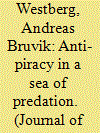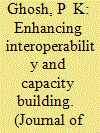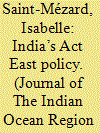|
|
|
Sort Order |
|
|
|
Items / Page
|
|
|
|
|
|
|
| Srl | Item |
| 1 |
ID:
148062


|
|
|
|
|
| Summary/Abstract |
How do anti-piracy forces engage with the coast of Somalia? Several studies have criticised the navies for being ineffective and stumbling in their fight against pirates and in their engagement with local communities. Somali sentiments are reportedly coloured by considerable scepticism towards the international naval effort, not least due to a feeling of double standards towards foreign trawlers seen plundering the country's resources. This study investigates the naval–coastal nexus along the Somali coast by drawing on field research off- and onshore. It finds that anti-piracy forces’ presence have had a considerable impact on the decline in piracy. Moreover, naval–coastal engagement and cooperation run deeper than is commonly perceived. While grievances against illegal fishing are widespread, examination of the fishing sector reveals a significant amount of predation committed by local stakeholders. Competition for fishing sector rents, particularly over distribution of licences, occurs on the local, regional and national levels. Bonds between some pirates, smugglers and officials threaten coastal community development and undermine their security. This study concludes that Somalia's maritime predatory trap can only be broken when former pirate villages are engaged as equal partners in the regional blue economy.
|
|
|
|
|
|
|
|
|
|
|
|
|
|
|
|
| 2 |
ID:
148061


|
|
|
|
|
| Summary/Abstract |
India perceives itself as a net security provider and a balancer of power in the Indian Ocean Region (IOR). This has resulted in the emergence of the Indian Navy (IN) as an important actor in the implementation of India’s foreign policy that embraces a holistic approach towards maritime security cooperation and capacity building. Having overcome its Cold War era isolationistic profile, the IN has expanded its maritime outreach in the IOR and beyond the region. Given that India is perceived as a benign power this has proved to be a strategic advantage in favor of India. The prime driver of increasing role of IN is to counter Chinese moves in the IOR following New Delhi’s discomfort and apprehension with China. To address this, the IN has been conducting regular joint exercises for enhancing interoperability, largesse towards weapon inventory, port visits and coordinated patrols, and assistance. In addition, the IN follows a cooperative approach for sharing of security-related technology. In this manner, the IN has successfully furthered India’s foreign policy objectives while achieving its maritime and strategic aims.
|
|
|
|
|
|
|
|
|
|
|
|
|
|
|
|
| 3 |
ID:
148056


|
|
|
|
|
| Summary/Abstract |
International relations are in a state of dynamic transition, with the emergence of an assertive China, growing India and the United States (US) as main players in the Indian Ocean region (IOR). China’s increasing geopolitical influence (developed in the so-called String of Pearls theory) and assertiveness in the South China Seas, complemented by the US policy aimed at enhancing operational integration in the region has led India to realign and outline its strategic vision under Prime Minister Narendra Modi to play a significant role in the IOR. This Special Issue of JIOR fleshes out this theme and other related topical issues in the region, focussing in particular on the growing interplay between China, India and the US – the three pillars – that play an increasingly important role in the reconfiguration of geopolitics in the IOR.
|
|
|
|
|
|
|
|
|
|
|
|
|
|
|
|
| 4 |
ID:
148059


|
|
|
|
|
| Summary/Abstract |
This paper examines the evolving geopolitical developments in the Indo-Pacific region, especially through the lens of an India–US–China trilateral/tripolar framework. At a time when ‘strategic unease’ has become a defining characteristic of the region and ‘security alignments and strategic hedging’ a prevalent diplomatic tendency, this paper captures an evolving trend of convergence in the strategic visions of the three key Indo-Pacific players – India, China and the US, and rising bilateral strategic/defence cooperation between them. Using a constructivist approach, this paper explores the feasibility of a trilateral cooperative framework among the three countries in near future.
|
|
|
|
|
|
|
|
|
|
|
|
|
|
|
|
| 5 |
ID:
148060


|
|
|
|
|
| Summary/Abstract |
Since the Modi government came to power in June 2014, it has invested diplomatic capital in announcing the transformation of India’s ‘Look East’ policy into a new ‘Act East’ policy. While this new semantics has mostly involved a few nuances and adjustments – rather than a drastic change – in India’s strategic posture, it is nevertheless interesting to analyze the implications of the ‘Act East’ policy for the Indian Ocean Region, and more specifically for its Eastern part – the Bay of Bengal. In this respect, the article shows that India’s ‘Act East’ policy has led to its growing involvement in the Bay of Bengal, especially in the field of maritime affairs. It has also led India to acknowledge its security responsibilities. More generally, India’s recent advances in maritime domain awareness, its interests in enhancing joint patrols and humanitarian assistance and disaster relief (HADR) cooperation, as well as its efforts to contribute to the maritime security of its neighbors, including through weapon transfers, reflect that India is in a nascent positioning as a net security provider, or at least is in an attempt to progress along that line.
|
|
|
|
|
|
|
|
|
|
|
|
|
|
|
|
| 6 |
ID:
148057


|
|
|
|
|
| Summary/Abstract |
The Indian Ocean lies at the core of India’s maritime strategy. Despite the fact that post independence it did not receive the attention it deserved due to several structural and policy inadequacies, India is pursuing a twin strategy of bolstering maritime defense capacity and harnessing maritime resources. The former is aimed to equip India with the capability to undertake maritime operation in the Indian Ocean, while the latter is to devise a cooperative strategy to harness maritime resources and deal with common challenges that confront the South Asian littoral states. This article examines the evolution of India’s approach to the Indian Ocean in the context of China’s growing presence in the region. It analyzes India’s policies toward South Asian maritime neighbors, their responses to India’s strategies and examines what the future holds for India in the emerging geopolitical context.
|
|
|
|
|
|
|
|
|
|
|
|
|
|
|
|
| 7 |
ID:
148058


|
|
|
|
|
| Summary/Abstract |
The Bay of Bengal is of vital strategic, economic and maritime importance, as the Andaman Sea and the Malacca Straits link South and Southeast Asia. The Bay is intrinsically rich in hydrocarbons and minerals. Several major rivers of Asia flow into the Bay and the adjoining seas creating vast sedimentary basins that have potential hydrocarbon deposits. The growing role of the Bay of Bengal as a reservoir of vital resources has contributed to the regional powers’ ability to exert influence in this arena. The changing dynamics are particularly relevant for India and China, whose rising economies are dependent on the steady flow of resources, most importantly oil. The geopolitics of the increasingly volatile South China Sea could possibly impact on India’s interests and relations with Southeast Asian countries. This paper examines whether China and India’s Indian Ocean strategies underpin greater cooperation, rather than competition to generate synergies in the region.
|
|
|
|
|
|
|
|
|
|
|
|
|
|
|
|
|
|
|
|
|